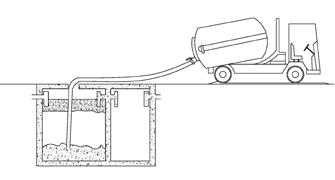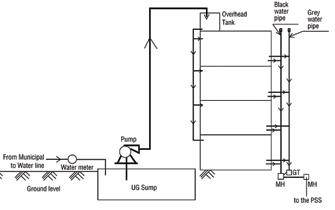
5 minute read
CHAPTER 3: Sewerage Connections – When New Public Sewerage Network is Commissioned
Sewerage Connections – When New Public Sewerage Network is Commissioned
Chapter Objective:
Advertisement
• The chapter highlights the additional details that plumbers should know in connecting building sewage to the new public sewerage system.
• It briefs about the delinking of the existing septic tank and connecting the building drainage to the PSS. Secondly, the septic tank being connected to the PSS through small bore system.
Chapter Duration: 80 minutes*
SECTION 1: New PSS network
Municipal byelaws
The Municipal byelaws provide laws for the owner of any property to dispose off his wastewater in a proper manner without causing any nuisance to others. Wherever Municipal sewers exist with some specified distance, it is obligatory that the wastewater of the property is discharged into it. The byelaws provide for action against defaulting owners.
However, in the case of areas not originally served with sewerage facilities, the owners may have to be persuaded to avail of the facilities provided to dispose off their wastewaters and in some cases it may even become necessary for the local body to show some incentive like loan/ subsidy for getting the works necessary to dispose the waste water into such municipal sewers.
Advantage of PSS:
1. The property is free from pollution. 2. The owner need not bother about the disposal of sludge and safe disposal of effluent from the septic tank by the way of secondary treatment. 3. In the absence of PSS, the sight of Septic tank and the ventilation pipes is an eyesore in the premises. 4. In the absence of PSS, the septic tanks and the effluent disposal occupy a sizable quantity of land area. 5. If the effluent is not disposed safely, the incumbents may be subjected to health problems.
Disposals of building drainage
It is the usual practice where public sewerage system is available; the house drain should be connected to the public sewer with the approval and as directed by the authority.
Where discharge into a public sewer is not possible, the drainage of the building normally done through one of the following individual disposal systems:
a) Leaching cess pool b) Collecting in well, cleared periodically and wastes taken to a central treatment and disposal site; and c) Septic tank and the effluent is discharged in to soil absorption system, Biological filters and up flow anaerobic filters.
Alter Building drainage system and connect to PSS
• bypassing the septic tank • via the septic tank
SECTION 2: Alteration of building drain to PSS (bypassing the septic tank) and alteration via septic tank to PSS
Drain Connected to Septic Tank
Option 1 – Delinking Option 2 – Septic Tank as interceptor tank 6. The sludge pipe shall deliver the sludge to a sump and provided with a delivery valve to draw the sludge as required.
7. Portable pumps may be used avoiding sludge pipe and pump.
8. The sludge should be conveyed to a suitable vehicle for removal from the site.
9. The latest trend is to engage a Vacuum tanker for desludging a septic tank.
10. Supposing, the tank is full and tank start delivering the waste water entering the tank and the septic tank is connected to the PSS through SBS, then the small bore pipe designed to carry liquid only may not be able to convey the solid waste causing blockage. This should be avoided by pre-planning the desludging activity.
B. Option 2
Conceived and drawn from IS 12183 (Part 1): 1987 - Reaffirmed in 2004 & IS 1742: 1983 - Reaffirmed in 2002

Figure 39: Water supply and sewerage system of a building – the drain connected to PSS
A. Option 1
Delink the drainage connection to the existing septic tank inside the premises, get a new service connection from the authority and connect the house drain to PSS with the approval of the authority. The connecting building drain to public sewer system is already explained in Chapter 2: Section 2. The existing septic tank should be desludged and the structure should be removed immediately.
• Steps involved in desludging the septic tank:
1. Manual handling of sludge is prohibited on public health point of view.
2. Care should be taken that the sludge does not spread on the ground.
3. The plumber should bear in mind the design period of the septic tank for sludge withdrawal.
4. Before the end of design period, it should be ensured that the tank is not full and attain the condition of overflow. Then start desludging. If the sludge layer is within 300 mm of the bottom of either the inlet or outlet, or if the bottom of the scum layer is within 75 mm of the bottom of the outlet, the tank should be desludged.
Conceived and drawn from IS 2470 (Part 1) : 1985 - Reaffirmed in 2001
Figure 40: Vacuum tanker desludging a septic tank
• The effluent from the septic tank may be connected to Public sewerage system or small bore system as the case may be with the approval of the authority.
• In this case as the solids are retained in the septic tank itself and only liquid waste alone is transported to the PSS, the cost of execution will be less.
• A small diameter pipe of 100 mm may be used. But the septic tank will act as a collection tank.
In the case of interceptor tank, the intercepting tank in principle is a single compartment septic tank. The tank effluent is connected to the SBS/Gravity sewerage system /Simplified sewers instead of connecting to an individual disposal system.
Conceived and drawn from IS 12183 (Part 1): 1987 - Reaffirmed in 2004 & IS 1742: 1983 - Reaffirmed in 2002

Figure 41: Water supply and sewerage system of a building – the drain connected to SBS/PSS through septic tank as interceptor tank
Field Visit
As a group, inspect new sewerage commissioned site
Find out what alterations are being made to bypass the Septic Tanks to send the effluents directly into the newly commissioned sewerage.









